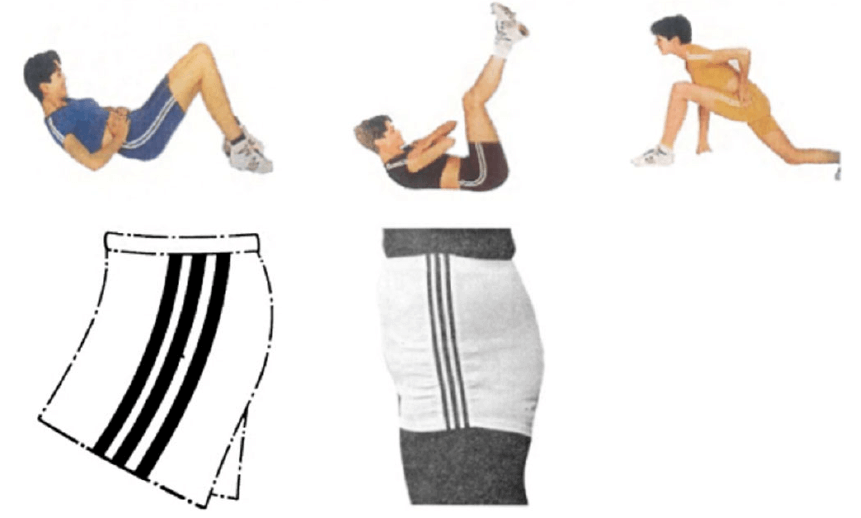
Who’s earned their stripes?
Adidas AG v H&M Hennis & Mauritz Netherlands BV – ECLI:NL:HR:2021:1474
Following a 24-year-long fight, Adidas lost the battle of the stripes trade mark against H&M on 8 October 2021 as the Dutch Supreme Court rejected Adidas’ final appeal. This dispute first arose in 1997 when H&M started selling its ‘Work Out’ range of fitness clothes in the Netherlands. The range included a design of clothing with two-stripes. Adidas is known for its success in protecting its three-stripe marks in the Netherlands.
The marks
Adidas owns several figurative Benelux and EU registrations for trade marks composed of three vertical, parallel stripes of equal width which are found on the sides of sports and leisure clothing in a colour which contrasts with the basic colour of the clothing. H&M’s Work Out fitness clothes (available in blue, yellow and brown) contained a white parallel two-stripe element on the sides of the clothing pieces.

(source: ECLI: NL: GHDHA : 2020:72)
Litigation history
- 2 October 1997 – the Breda District Court issued a preliminary injunction against H&M to refrain H&M from using the two-stripe trade marks.
- 13 October 1998 – the Breda District Court held that the H&M signs were considered an infringement of the three-stripe trade marks.
- 29 March 2005 – the ‘s-Hertogenbosch Court of Appeal set aside the judgments of 2 October 1997 and 13 October 1998 and rejected both Adidas and H&M’s claims. The Court held that the three-stripe trade marks had not been infringed by H&M, and the scope of the claims made by Adidas were too broad. The Court further concluded that stripes and simple stripe logos are generally signs that must remain available and do not therefore lend themselves to exclusive rights.
- Adidas then appealed the Court of Appeal decision to the Dutch Supreme Court who decided to stay the proceedings and refer the question to the CJEU who ruled in favour of Adidas in April 2008.
- In accordance with Dutch law, Adidas then initiated proceedings on the merits in order to uphold and enforce a preliminary injunction. The Hague District Court granted the injunction on 8 November 2017.
- 28 January 2020 – following an appeal by H&M, the Hague Court of Appeal ruled that H&M can use a specific two-stripe sign (as part of its ‘Work Out’ clothing line) on its sports clothing without infringing Adidas’ three-stripe trade marks. This decision was as a result of the overall assessment of the marks and signs, and the apparent dissimilar positioning and distance between the stripes.
- 8 October 2021 – the Dutch Supreme Court dismissed Adidas’ appeal and agreed with The Hague Court of Appeal decision, ruling that Adidas’ trade mark had not been infringed by H&M.
Similarity of the marks
The scope of protection of Adidas’ three-stripe mark is defined by the spacing between the stripes in relation to the width of the stripes. H&M’s sports clothing was deemed to fall outside the scope of Adidas’ infringement claim, because the spacing between the two stripes was smaller to a relevant extent than the stripes themselves. The Dutch Supreme Court therefore agreed with the Hague Court of Appeal and held that the condition that the spacing between the stripes was visually more or less equal to the width of the stripes was not met.
Likelihood of confusion
The Dutch Supreme Court also held that H&M’s two-stripe sign and Adidas’ three-stripe mark were similar only to a very low degree. This was supported by the Hague Court of Appeal’s analysis which hinged on survey evidence submitted by H&M, countering Adidas’ consumer survey results on consumer confusion by highlighting the market leader effect. This explained because Adidas is a market leader in sportswear, a certain percentage of respondents will answer ‘Adidas’ in any case when asked about the origin of a piece of sportswear.
Conclusion
The Dutch Court rejected the appeal and ordered Adidas to pay H&M’s costs in the proceedings, estimated to be €23,000 up to this judgment, plus statutory interest on these costs if they are not paid within 14 days.
This result was surprising given the three lower court decisions in this case, which all confirmed infringement of the three-stripe mark. This was mainly due to Adidas’ reputation and distinctiveness around the world. This decision provides guidance for similar situations, where a registered trade mark may not extend its protection to similar marks.








